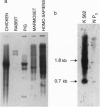Abstract
The TCL1 locus on chromosome 14 band q32.1 is frequently involved in the chromosomal translocations and inversions with the T-cell receptor genes observed in several T-cell tumors, including T-prolymphocytic leukemias, acute and chronic leukemias associated with the immunodeficiency syndrome ataxia-telangiectasia, and adult T-cell leukemia. All breakpoints cloned in this area have been mapped to 14q32.1, an area distant approximately 10,000 kb from the immunoglobulin heavy-chain gene locus on chromosome 14q band 32.3. Except for two cases of inversion, no physical linkage of the cloned breakpoints has been reported, nor has a gene been identified in this region. Taking advantage of chromosome-walking techniques and of the P1 phage, we cloned and characterized 450 kb of the germ-line TCL1 locus, starting from the breakpoints of two independent T-cell leukemias. We show that all molecular rearrangements characterized so far map to these clones, indicating not only that this region is the target of chromosomal rearrangements occurring in this area but also that both inversion and translocations occur within a 300-kb region in the T-cell leukemias. In the attempt to identify a candidate oncogene responsible for the malignant transformation, a CpG island centromeric to the inversions and to the translocations has been identified. Two probes near the CpG island have detected sequences conserved among species, as well as two transcripts in the K562 human erythroleukemia cell line. On the basis of these data, a model of activation of the putative TCL1 oncogene is suggested.
Full text
PDF
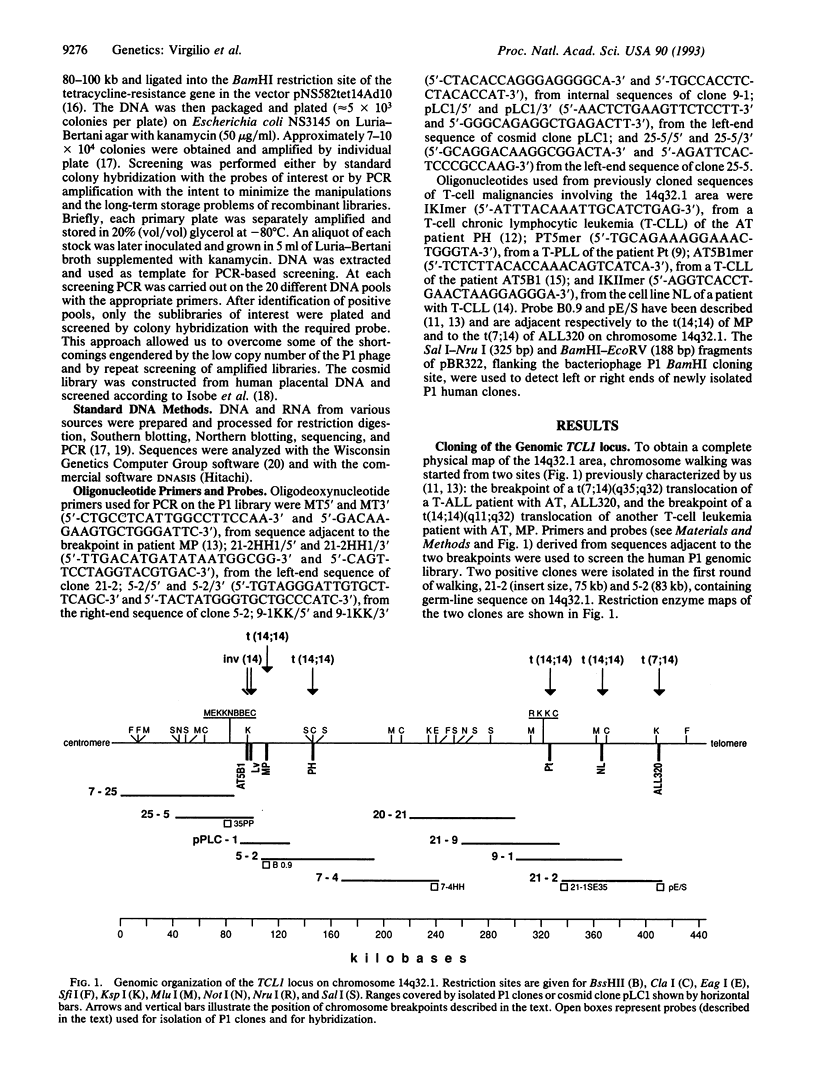
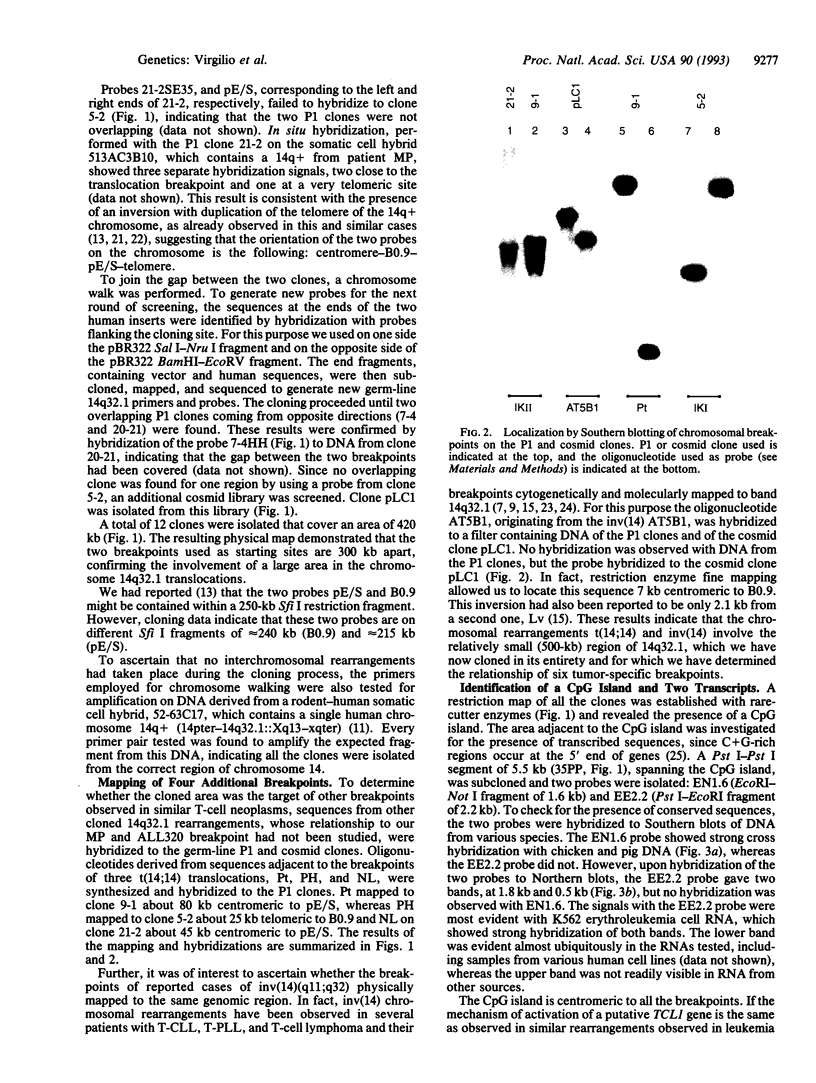
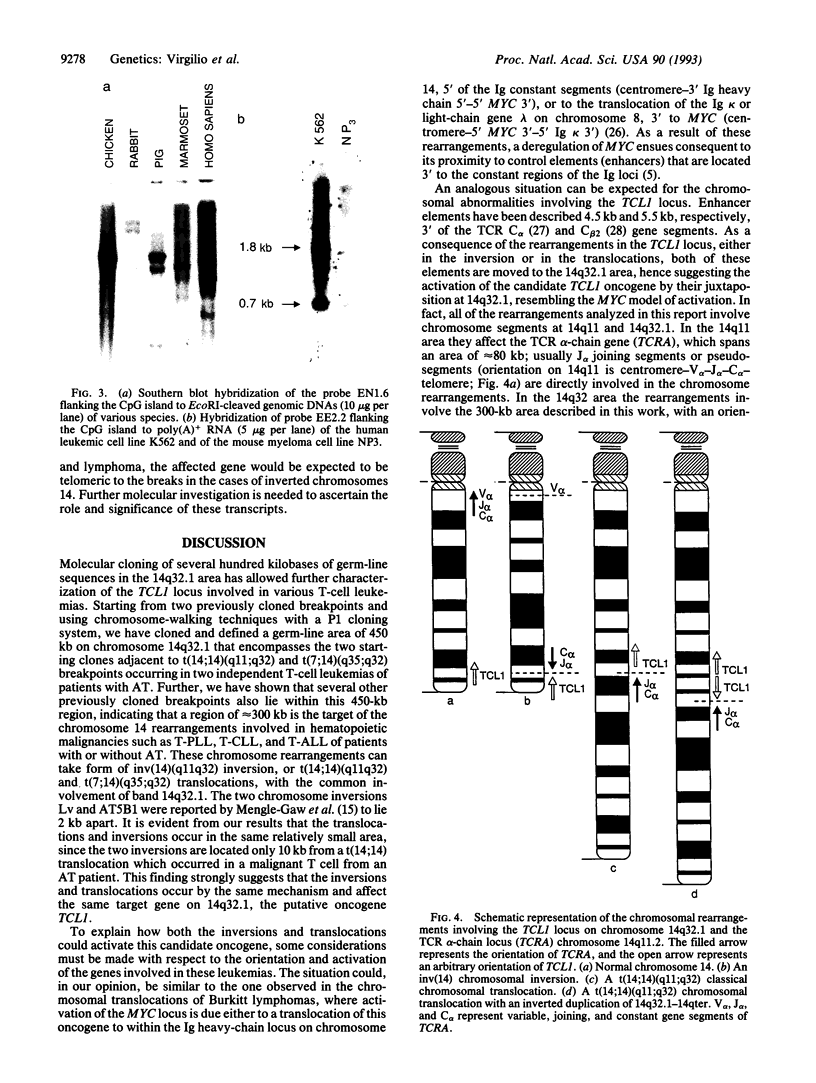
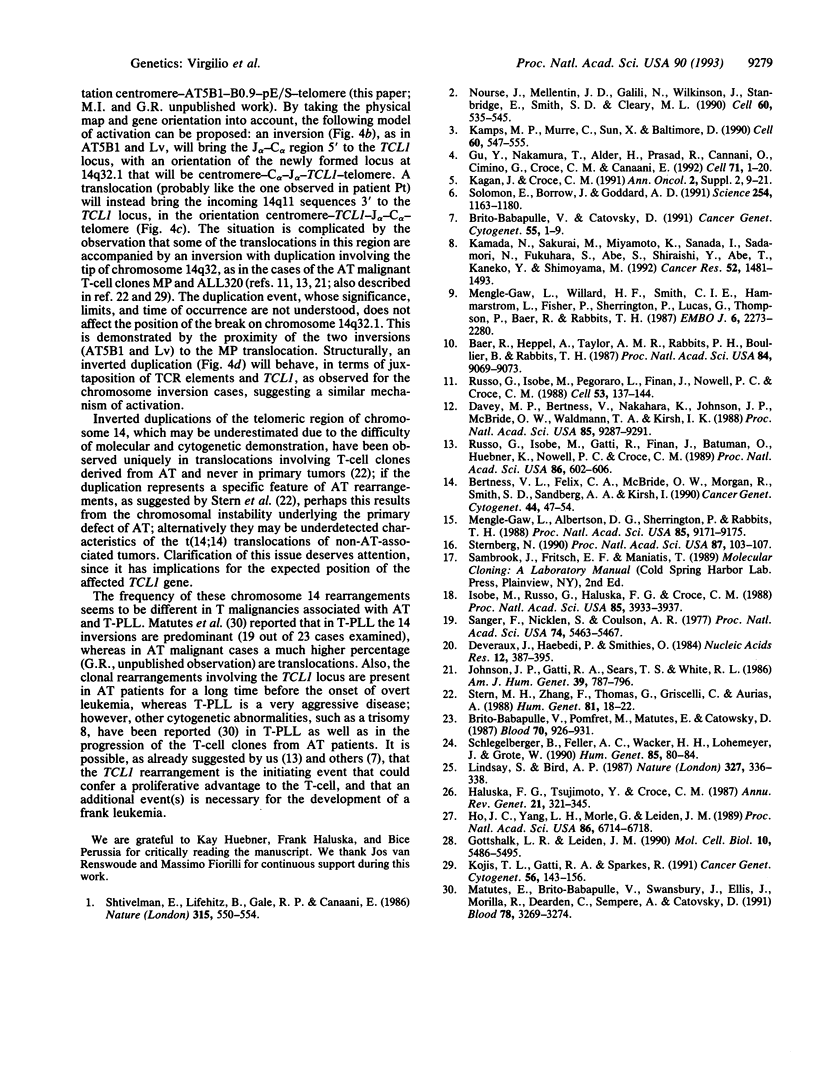
Images in this article
Selected References
These references are in PubMed. This may not be the complete list of references from this article.
- Baer R., Heppell A., Taylor A. M., Rabbitts P. H., Boullier B., Rabbitts T. H. The breakpoint of an inversion of chromosome 14 in a T-cell leukemia: sequences downstream of the immunoglobulin heavy chain locus are implicated in tumorigenesis. Proc Natl Acad Sci U S A. 1987 Dec;84(24):9069–9073. doi: 10.1073/pnas.84.24.9069. [DOI] [PMC free article] [PubMed] [Google Scholar]
- Bertness V. L., Felix C. A., McBride O. W., Morgan R., Smith S. D., Sandberg A. A., Kirsch I. R. Characterization of the breakpoint of a t(14;14)(q11.2;q32) from the leukemic cells of a patient with T-cell acute lymphoblastic leukemia. Cancer Genet Cytogenet. 1990 Jan;44(1):47–54. doi: 10.1016/0165-4608(90)90196-h. [DOI] [PubMed] [Google Scholar]
- Brito-Babapulle V., Catovsky D. Inversions and tandem translocations involving chromosome 14q11 and 14q32 in T-prolymphocytic leukemia and T-cell leukemias in patients with ataxia telangiectasia. Cancer Genet Cytogenet. 1991 Aug;55(1):1–9. doi: 10.1016/0165-4608(91)90228-m. [DOI] [PubMed] [Google Scholar]
- Brito-Babapulle V., Pomfret M., Matutes E., Catovsky D. Cytogenetic studies on prolymphocytic leukemia. II. T cell prolymphocytic leukemia. Blood. 1987 Oct;70(4):926–931. [PubMed] [Google Scholar]
- Davey M. P., Bertness V., Nakahara K., Johnson J. P., McBride O. W., Waldmann T. A., Kirsch I. R. Juxtaposition of the T-cell receptor alpha-chain locus (14q11) and a region (14q32) of potential importance in leukemogenesis by a 14;14 translocation in a patient with T-cell chronic lymphocytic leukemia and ataxia-telangiectasia. Proc Natl Acad Sci U S A. 1988 Dec;85(23):9287–9291. doi: 10.1073/pnas.85.23.9287. [DOI] [PMC free article] [PubMed] [Google Scholar]
- Devereux J., Haeberli P., Smithies O. A comprehensive set of sequence analysis programs for the VAX. Nucleic Acids Res. 1984 Jan 11;12(1 Pt 1):387–395. doi: 10.1093/nar/12.1part1.387. [DOI] [PMC free article] [PubMed] [Google Scholar]
- Garbers D. L. Guanylyl cyclase receptors and their endocrine, paracrine, and autocrine ligands. Cell. 1992 Oct 2;71(1):1–4. doi: 10.1016/0092-8674(92)90258-e. [DOI] [PubMed] [Google Scholar]
- Gottschalk L. R., Leiden J. M. Identification and functional characterization of the human T-cell receptor beta gene transcriptional enhancer: common nuclear proteins interact with the transcriptional regulatory elements of the T-cell receptor alpha and beta genes. Mol Cell Biol. 1990 Oct;10(10):5486–5495. doi: 10.1128/mcb.10.10.5486. [DOI] [PMC free article] [PubMed] [Google Scholar]
- Haluska F. G., Tsujimoto Y., Croce C. M. Oncogene activation by chromosome translocation in human malignancy. Annu Rev Genet. 1987;21:321–345. doi: 10.1146/annurev.ge.21.120187.001541. [DOI] [PubMed] [Google Scholar]
- Ho I. C., Yang L. H., Morle G., Leiden J. M. A T-cell-specific transcriptional enhancer element 3' of C alpha in the human T-cell receptor alpha locus. Proc Natl Acad Sci U S A. 1989 Sep;86(17):6714–6718. doi: 10.1073/pnas.86.17.6714. [DOI] [PMC free article] [PubMed] [Google Scholar]
- Isobe M., Russo G., Haluska F. G., Croce C. M. Cloning of the gene encoding the delta subunit of the human T-cell receptor reveals its physical organization within the alpha-subunit locus and its involvement in chromosome translocations in T-cell malignancy. Proc Natl Acad Sci U S A. 1988 Jun;85(11):3933–3937. doi: 10.1073/pnas.85.11.3933. [DOI] [PMC free article] [PubMed] [Google Scholar]
- Johnson J. P., Gatti R. A., Sears T. S., White R. L. Inverted duplication of JH associated with chromosome 14 translocation and T-cell leukemia in ataxia-telangiectasia. Am J Hum Genet. 1986 Dec;39(6):787–796. [PMC free article] [PubMed] [Google Scholar]
- Kagan J., Croce C. M. Molecular biology of lymphoid malignancies. Ann Oncol. 1991 Feb;2 (Suppl 2):9–21. doi: 10.1007/978-1-4899-7305-4_2. [DOI] [PubMed] [Google Scholar]
- Kamada N., Sakurai M., Miyamoto K., Sanada I., Sadamori N., Fukuhara S., Abe S., Shiraishi Y., Abe T., Kaneko Y. Chromosome abnormalities in adult T-cell leukemia/lymphoma: a karyotype review committee report. Cancer Res. 1992 Mar 15;52(6):1481–1493. [PubMed] [Google Scholar]
- Kamps M. P., Murre C., Sun X. H., Baltimore D. A new homeobox gene contributes the DNA binding domain of the t(1;19) translocation protein in pre-B ALL. Cell. 1990 Feb 23;60(4):547–555. doi: 10.1016/0092-8674(90)90658-2. [DOI] [PubMed] [Google Scholar]
- Kojis T. L., Gatti R. A., Sparkes R. S. The cytogenetics of ataxia telangiectasia. Cancer Genet Cytogenet. 1991 Oct 15;56(2):143–156. doi: 10.1016/0165-4608(91)90164-p. [DOI] [PubMed] [Google Scholar]
- Lindsay S., Bird A. P. Use of restriction enzymes to detect potential gene sequences in mammalian DNA. 1987 May 28-Jun 3Nature. 327(6120):336–338. doi: 10.1038/327336a0. [DOI] [PubMed] [Google Scholar]
- Matutes E., Brito-Babapulle V., Swansbury J., Ellis J., Morilla R., Dearden C., Sempere A., Catovsky D. Clinical and laboratory features of 78 cases of T-prolymphocytic leukemia. Blood. 1991 Dec 15;78(12):3269–3274. [PubMed] [Google Scholar]
- Mengle-Gaw L., Albertson D. G., Sherrington P. D., Rabbitts T. H. Analysis of a T-cell tumor-specific breakpoint cluster at human chromosome 14q32. Proc Natl Acad Sci U S A. 1988 Dec;85(23):9171–9175. doi: 10.1073/pnas.85.23.9171. [DOI] [PMC free article] [PubMed] [Google Scholar]
- Mengle-Gaw L., Willard H. F., Smith C. I., Hammarström L., Fischer P., Sherrington P., Lucas G., Thompson P. W., Baer R., Rabbitts T. H. Human T-cell tumours containing chromosome 14 inversion or translocation with breakpoints proximal to immunoglobulin joining regions at 14q32. EMBO J. 1987 Aug;6(8):2273–2280. doi: 10.1002/j.1460-2075.1987.tb02501.x. [DOI] [PMC free article] [PubMed] [Google Scholar]
- Nourse J., Mellentin J. D., Galili N., Wilkinson J., Stanbridge E., Smith S. D., Cleary M. L. Chromosomal translocation t(1;19) results in synthesis of a homeobox fusion mRNA that codes for a potential chimeric transcription factor. Cell. 1990 Feb 23;60(4):535–545. doi: 10.1016/0092-8674(90)90657-z. [DOI] [PubMed] [Google Scholar]
- Russo G., Isobe M., Gatti R., Finan J., Batuman O., Huebner K., Nowell P. C., Croce C. M. Molecular analysis of a t(14;14) translocation in leukemic T-cells of an ataxia telangiectasia patient. Proc Natl Acad Sci U S A. 1989 Jan;86(2):602–606. doi: 10.1073/pnas.86.2.602. [DOI] [PMC free article] [PubMed] [Google Scholar]
- Russo G., Isobe M., Pegoraro L., Finan J., Nowell P. C., Croce C. M. Molecular analysis of a t(7;14)(q35;q32) chromosome translocation in a T cell leukemia of a patient with ataxia telangiectasia. Cell. 1988 Apr 8;53(1):137–144. doi: 10.1016/0092-8674(88)90495-3. [DOI] [PubMed] [Google Scholar]
- Sanger F., Nicklen S., Coulson A. R. DNA sequencing with chain-terminating inhibitors. Proc Natl Acad Sci U S A. 1977 Dec;74(12):5463–5467. doi: 10.1073/pnas.74.12.5463. [DOI] [PMC free article] [PubMed] [Google Scholar]
- Schlegelberger B., Feller A. C., Wacker H. H., Lohmeyer J., Grote W. Inv(14) with distal breakpoint in 14q32.1 in three cases of T cell lymphoma. Hum Genet. 1990 Jun;85(1):80–84. doi: 10.1007/BF00276328. [DOI] [PubMed] [Google Scholar]
- Shtivelman E., Lifshitz B., Gale R. P., Canaani E. Fused transcript of abl and bcr genes in chronic myelogenous leukaemia. Nature. 1985 Jun 13;315(6020):550–554. doi: 10.1038/315550a0. [DOI] [PubMed] [Google Scholar]
- Stern M. H., Zhang F. R., Thomas G., Griscelli C., Aurias A. Molecular characterization of ataxia telangiectasia T cell clones. III. Mapping the 14q32.1 distal breakpoint. Hum Genet. 1988 Dec;81(1):18–22. doi: 10.1007/BF00283722. [DOI] [PubMed] [Google Scholar]
- Sternberg N. Bacteriophage P1 cloning system for the isolation, amplification, and recovery of DNA fragments as large as 100 kilobase pairs. Proc Natl Acad Sci U S A. 1990 Jan;87(1):103–107. doi: 10.1073/pnas.87.1.103. [DOI] [PMC free article] [PubMed] [Google Scholar]




